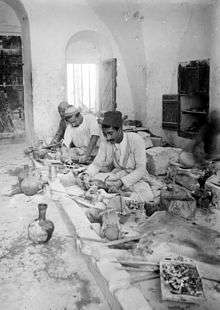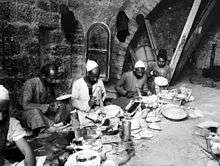Mother-of-Pearl carving in Bethlehem


Mother-of-Pearl carving, a traditional handicraft in Bethlehem, is said to have been brought to the city by Franciscan friars from Italy in the 15th century.[1]
Bethlehem's position as an important Christian city has for centuries attracted a constant stream of pilgrims. This generated much local work and income, also for women, including making mother-of-pearl souvenirs. According to Weir, Bethlehem women's employment in the mother-of-pearl industry goes back at least to the seventeenth century.[2] It was noted by Richard Pococke, who travelled there in 1727. [3]
Previously, most of the oysters for the mother-of-pearl supply came from the Red Sea. Today, however, Australia, California, New Zealand and Brazil are the main exporters.[4]
The first exhibition in the west of mother-of-pearl artifacts from Palestine was at The World Fair in New York in 1852. Two brothers, Giries and Ibrahim Mansur, exhibited their work and were a great success.[5]
Present day products, include crosses, earrings, brooches and picture frames.
References
| Wikimedia Commons has media related to Palestinian handicrafts. |
- ↑ Tourist Products, Palestine-family.net]
- ↑ Weir, p.128, 280, n.30
- ↑ A Description of the East and Some other Countries, p. 436
- ↑ Bethlehem municipality website
- ↑ Tourist Products, Palestine-family.net, 23.01.2007, Source:"Bethlehem, The Immortal Town" by Giries Elali
Bibliography
- Weir, Shelagh (1989). Palestinian Costume, London: British Museum Publications Ltd. ISBN 0-7141-2517-2. (exhibition catalog)
- Pococke, Richard (1811): A General Collection of the Best and Most Interesting Voyages and Travels in All Parts of the World: Many of which are Now First Translated Into English, (Popocke starts at p.406.)
See also
External links
- Mother of Pearl A Traditional Palestinian Craft By Saleem Zougbi, Based on the book, “Nacar di Palestina” by Enrique Jidi, Colombia.
- Tourist Products Palestine-family.net, 23.01.2007, Based on the book, "Bethlehem, The Immortal Town" by Giries Elali